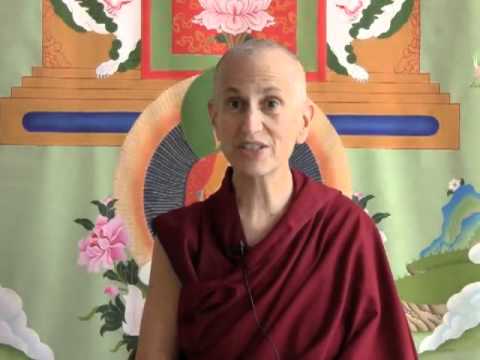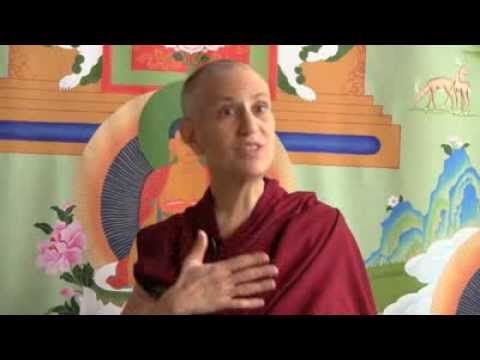Dullness and drowsiness
The third of five hindrances to concentration
This talk was given during the White Tara Winter Retreat at Sravasti Abbey.
- What to do if falling asleep during meditation session
- How drowsiness does not necessarily have anything to do with needing sleep
- The more subtle lethargy and laxity
- Importance of getting exercise
White Tara Retreat 26: Concentration hindrance of dullness and drowsiness (download)
The next thing that keeps us from concentrating when we are trying to do the visualization and the mantra is dullness and drowsiness. On a very gross level, we find ourselves nodding off and suddenly White Tara is morphing into something else. You know how you start to fall asleep and then you get different images and things? That is on a very gross level, which is the first level we have to deal with.
Falling asleep during meditation sessions
If you are having trouble with falling asleep try doing lots of prostrations before you sit down. The physical activity is good and also doing confession and purification counteracts some of the negativity that has the function of making us drowsy and dull. Another thing to do is to put cold water on your face. Check your meditation posture, make sure your back is straight and that your arms are correct, that there is some space here [indicating that the arms aren’t held tight to the side of the body but there’s space between the torso and arms], and your head is level. Really check your posture.
Try to make your visualization really bright; really brighten everything up. Of course, bright light is what you don’t want to have when you are falling asleep, which is why it is the antidote. You try and brighten it up. You can think of the light as really bright; or you can think of inhaling very bright light that really wakes you up.
Recognize that falling asleep does not necessarily mean that you lack sleep. We can be wide awake one minute when we’re fantasizing and daydreaming, and asleep the next minute. As soon as that fantasy comes back we are wide awake again. It has nothing to do with how many of hours of sleep we had the night before. By contrast, when you are angry, when you are distracted by ill will and maliciousness, you don’t get drowsy then do you? We are wide awake plotting our revenge. So you can see that the drowsiness is more a way in which our mind manifests resistance to meditation. We have lots of resistance and falling asleep is one of them. It is a sneaky one because we can always say, “Oh well, that’s because I didn’t sleep enough so I’d better skip session and sleep some more.” It’s very sneaky that way so we should really take care.
Don’t wear so many heavy clothes or sit in a really warm room or wrap yourself up in a blanket. That is also going to foster the sleepiness. You want to be a little bit cool. If you are cool, it helps you to stay awake.
Lethargy and laxity
This is a very gross kind of falling asleep and drowsiness. But then there is also a subtler kind of lethargy or laxity. The lethargy is where your mind is kind of on the object, but also kind of not on the object. It is like the mind is lagging behind in speed. You are going through the sadhana and you are reading what you are reading, but you are still somewhere behind. The laxity is even more subtle. There you might even be on the object of meditation but it is not very vital, or it is not very intense. Your clarity of the object is not so much there. You need to be aware of all these kinds of ways in which the mind tunes out with this foggy kind of obscuration.
Brighten your mind up. One way to brighten your mind up is to think of precious human life, or to think of the Three Jewels, or to think of Buddha nature—something that your mind finds uplifting will make you more interested in the meditation and less likely to get lethargic during it. Try that and keep working with it. Do not get discouraged if you go through a period where you are falling asleep a lot, or feel drowsy or lethargic or lax, but just keep working at it. Become aware of it, apply the antidotes.
I think it is very important in this one to make sure you get exercise. One reason that we chose this site for the Abbey is because of the view. It is so important when you are doing meditation that you look at the long view. This expands your mind; whereas dullness and so forth are making your mind inward and contracted. So, you want to look at long distances, look across at the hill, look at the empty sky, do some walking, do some yoga, or do some stretching.
Now, I know you have all heard me say this many times before, but how much do we actually do it? So that is one reason that it gets said again and again, maybe because one time we will think to try it. It is actually quite helpful. Keeping your mind happy, keeping that happy mind; reflecting on precious human life, refuge, Buddha nature, generating bodhicitta—so you have a loving mind that really wants to benefit sentient beings. All of that can really wake you up.
Audience: When you spoke about lethargy, when you are kind of on the object and kind of not—I’ve experienced a lot of that. But it seems like when there’s dullness, the part of my mind that’s not on the object is also dealing with excitement and desire.
Venerable Thubten Chodron: When your mind is not on the object and there is distraction and desire: then especially with desire, you are going to use the antidote of impermanence and seeing the defects of cyclic existence. But if your mind is just lethargic and heavy and dull, that is when you would use the more uplifting meditation. Sometimes your mind can lag behind because you are going off in another direction. That is different than if it’s lagging behind just because it is kind of dull and you are kind of spacey.
Venerable Thubten Chodron
Venerable Chodron emphasizes the practical application of Buddha’s teachings in our daily lives and is especially skilled at explaining them in ways easily understood and practiced by Westerners. She is well known for her warm, humorous, and lucid teachings. She was ordained as a Buddhist nun in 1977 by Kyabje Ling Rinpoche in Dharamsala, India, and in 1986 she received bhikshuni (full) ordination in Taiwan. Read her full bio.


